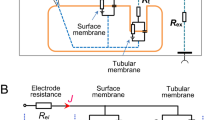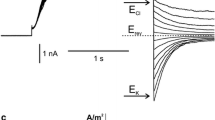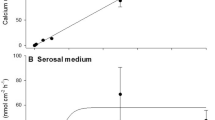Summary
When an isolated frog skin (Rana temporaria) is exposed to a hydrostatic pressure difference between inside and outside bathing solutions (inside pressure higher than outside) of 20–50 cm of H2O and if under these conditions the skin is short-circuited electrically, small “vacuoles” appear light-microscopically in the outermost living cell layer in the epithelium. The number of such “vacuoles” shows a linear dependency on the rate of active sodium transport as measured by the short-circuit current. Electron-microscopically, the “vacuoles” are interpreted as previously undescribed organelles, the “scalloped sacs” which are about 0.5 μ in diameter, with a wrinkled surface and bounded by a unit membrane. This organelle is in intimate contact with sacs and tubules of smooth endoplasmic reticulum. The observed increase in the number of scalloped sacs usually is accompanied by a significant expansion of the whole system of endoplasmic reticulum. Some of the “vacuoles” seen light-microscopically must indeed be expanded cisternae of endoplasmic reticulum. The findings are discussed in light of the possibility that the scalloped sacs and the endoplasmic reticulum may be involved in active transport of sodium ions.
Similar content being viewed by others
References
Eckert, H. 1969. Distribution of soluble substances at the ultrastructural level.In: Autoradiography of Diffusible Substances. L. J. Roth and W. E. Stumpf, editors. p. 321. Academic Press, New York-London
Elliot, A. M., editor. 1973. Biology of Tetrahymena. Dowden, Huchison and Ross, Inc., Stroudsburg, Pennsylvania
Farquhar, M. G., Palade, G. E. 1964. Functional organization of amphibian skin.Proc. Nat. Acad. Sci. 51:569
Huf, G. E. 1972. The role of Cl− and other anions in active Na+ transport in isolated frog skin.Acta Physiol. Scand. 84:366
Saladino, A. J., Bentley, P. J., Trump, B. F. 1969, Ion movement in cell injury.Amer. J. Pathol. 54:421
Ussing, H. H. 1965. Relationship between osmotic reactions and active sodium transport in the frog skin epithelium.Acta Physiol. Scand. 63:141
Ussing, H. H., Windhager, E. E. 1964. Nature of shunt path and active transport path through frog skin.Acta Physiol. Scand. 61:484
Ussing, H. H., Zerahn, K. 1951. Active transport of sodium as the source of electric current in the short-circuited isolated frog skin.Acta Physiol. Scand. 23:110
Voûte, C. L. 1973. Morphophysiological evidence for a two step active transport path for sodium in the epithelium of frog skin (Rana temporaria). (Abstract)Experientia 29:749
Voûte, C. L., Hänni, S. 1973. Relation between structure and function in frog skin.In: Transport Mechanisms in Epithelia.Proc. A. Benzon Symp. V. H. H. Ussing and N. A. Thorn, editors. p. 87. Munksgaard, Copenhagen
Voûte, C. L., Ussing, H. H. 1968. Some morphological aspects of active sodium transport. The epithelium of the frog skin.J. Cell Biol. 36:625
Voûte, C. L., Ussing, H. H. 1970a. The morphological aspects of shunt-path in the epithelium of the frog skin (R. temporaria).Exp. Cell Res. 61:133
Voûte, C. L., Ussing, H. H. 1970b. Quantitative relation between hydrostatic pressure gradient, extracellular volume and active sodium transport in the epithelium of the frog skin (R. temporaria).Exp. Cell Res. 62:375
Zerahn, K. 1969. Nature and localization of the sodium pool during active transport in the isolated frog skin.Acta Physiol. Scand. 77:272
Author information
Authors and Affiliations
Rights and permissions
About this article
Cite this article
Voûte, C.L., Møllgård, K. & Ussing, H.H. Quantitative relationship between active sodium transport, expansion of endoplasmic reticulum and specialized vacuoles (“scalloped sacs”) in the outermost living cell layer of the frog skin epithelium (Rana temporaria). J. Membrain Biol. 21, 273–289 (1975). https://doi.org/10.1007/BF01941072
Received:
Revised:
Issue Date:
DOI: https://doi.org/10.1007/BF01941072




